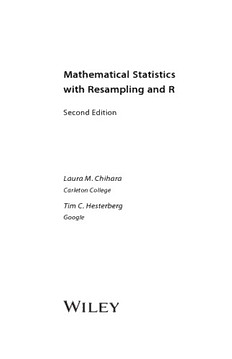Table Of ContentMathematical Statistics
with Resampling and R
SecondEdition
LauraM.Chihara
CarletonCollege
TimC.Hesterberg
Google
Thissecondeditionfirstpublished2019
©2019byJohnWiley&Sons,Inc.
EditionHistory
MathematicalStatisticswithResamplingandR,Wiley,2011
LibraryofCongressCataloging-in-PublicationData:
Names:Chihara,Laura,1957–author.|Hesterberg,Tim,1959–author.
Title:MathematicalstatisticswithresamplingandR/LauraM.Chihara
(CarletonCollege),TimC.Hesterberg(Google).
Description:Secondedition.|Hoboken,NJ:Wiley,2019.|Includes
bibliographicalreferencesandindex.|
Identifiers:LCCN2018008774(print)|LCCN2018013587(ebook)|ISBN
9781119416524(pdf)|ISBN9781119416531(epub)|ISBN9781119416548
(cloth)
Subjects:LCSH:Resampling(Statistics)|Statistics.|Statistics–Data
processing.|Mathematicalstatistics–Dataprocessing.|R(Computer
programlanguage)
Classification:LCCQA278.8(ebook)|LCCQA278.8.C452018(print)|DDC
519.5/4–dc23
LCrecordavailableathttps://lccn.loc.gov/2018008774
CoverdesignbyWiley
Coverimages:CourtesyofCarletonCollege
Setin10/12ptWarnockbySPiGlobal,Pondicherry,India
PrintedintheUnitedStatesofAmerica
Contents
Preface xiii
1 DataandCaseStudies 1
1.1 CaseStudy:FlightDelays 1
1.2 CaseStudy:BirthWeightsofBabies 2
1.3 CaseStudy:VerizonRepairTimes 3
1.4 CaseStudy:IowaRecidivism 4
1.5 Sampling 5
1.6 ParametersandStatistics 6
1.7 CaseStudy:GeneralSocialSurvey 7
1.8 SampleSurveys 8
1.9 CaseStudy:BeerandHotWings 9
1.10 CaseStudy:BlackSpruceSeedlings 10
1.11 Studies 10
1.12 GoogleInterviewQuestion:MobileAdsOptimization 12
Exercises 16
2 ExploratoryDataAnalysis 21
2.1 BasicPlots 21
2.2 NumericSummaries 25
2.2.1 Center 25
2.2.2 Spread 26
2.2.3 Shape 27
2.3 Boxplots 28
2.4 QuantilesandNormalQuantilePlots 29
2.5 EmpiricalCumulativeDistributionFunctions 35
2.6 ScatterPlots 38
2.7 SkewnessandKurtosis 40
Exercises 42
3 IntroductiontoHypothesisTesting:PermutationTests 47
3.1 IntroductiontoHypothesisTesting 47
3.2 Hypotheses 48
3.3 PermutationTests 50
3.3.1 ImplementationIssues 55
3.3.2 One-sidedandTwo-sidedTests 61
3.3.3 OtherStatistics 62
3.3.4 Assumptions 64
3.3.5 RemarkonTerminology 68
3.4 MatchedPairs 68
Exercises 70
4 SamplingDistributions 75
4.1 SamplingDistributions 75
4.2 CalculatingSamplingDistributions 80
4.3 TheCentralLimitTheorem 84
4.3.1 CLTforBinomialData 86
4.3.2 ContinuityCorrectionforDiscreteRandomVariables 89
4.3.3 AccuracyoftheCentralLimitTheorem∗ 91
4.3.4 CLTforSamplingWithoutReplacement 92
Exercises 93
5 IntroductiontoConfidenceIntervals:TheBootstrap 103
5.1 IntroductiontotheBootstrap 103
5.2 ThePlug-inPrinciple 110
5.2.1 EstimatingthePopulationDistribution 112
5.2.2 HowUsefulIstheBootstrapDistribution? 113
5.3 BootstrapPercentileIntervals 118
5.4 Two-SampleBootstrap 119
5.4.1 MatchedPairs 124
5.5 OtherStatistics 128
5.6 Bias 131
5.7 MonteCarloSampling:The“SecondBootstrapPrinciple” 134
5.8 AccuracyofBootstrapDistributions 135
5.8.1 SampleMean:LargeSampleSize 135
5.8.2 SampleMean:SmallSampleSize 137
5.8.3 SampleMedian 138
5.8.4 Mean–VarianceRelationship 138
5.9 HowManyBootstrapSamplesAreNeeded? 140
Exercises 141
6 Estimation 149
6.1 MaximumLikelihoodEstimation 149
6.1.1 MaximumLikelihoodforDiscreteDistributions 150
6.1.2 MaximumLikelihoodforContinuousDistributions 153
6.1.3 MaximumLikelihoodforMultipleParameters 157
6.2 MethodofMoments 161
6.3 PropertiesofEstimators 163
6.3.1 Unbiasedness 164
6.3.2 Efficiency 167
6.3.3 MeanSquareError 171
6.3.4 Consistency 173
6.3.5 TransformationInvariance∗ 175
6.3.6 AsymptoticNormalityofMLE∗ 177
6.4 StatisticalPractice 178
6.4.1 AreYouAskingtheRightQuestion? 179
6.4.2 Weights 179
Exercises 180
7 MoreConfidenceIntervals 187
7.1 ConfidenceIntervalsforMeans 187
7.1.1 ConfidenceIntervalsforaMean,VarianceKnown 187
7.1.2 ConfidenceIntervalsforaMean,VarianceUnknown 192
7.1.3 ConfidenceIntervalsforaDifferenceinMeans 198
7.1.4 MatchedPairs,Revisited 204
7.2 ConfidenceIntervalsinGeneral 204
7.2.1 LocationandScaleParameters∗ 208
7.3 One-sidedConfidenceIntervals 212
7.4 ConfidenceIntervalsforProportions 214
7.4.1 Agresti–CoullIntervalsforaProportion 217
7.4.2 ConfidenceIntervalsforaDifferenceofProportions 218
7.5 BootstrapConfidenceIntervals 219
7.5.1 tConfidenceIntervalsUsingBootstrapStandardErrors 219
7.5.2 BootstraptConfidenceIntervals 220
7.5.3 ComparingBootstraptandFormulatConfidenceIntervals 224
7.6 ConfidenceIntervalProperties 226
7.6.1 ConfidenceIntervalAccuracy 226
7.6.2 ConfidenceIntervalLength 227
7.6.3 TransformationInvariance 227
7.6.4 EaseofUseandInterpretation 227
7.6.5 ResearchNeeded 228
Exercises 228
8 MoreHypothesisTesting 241
8.1 HypothesisTestsforMeansandProportions:OnePopulation 241
8.1.1 ASingleMean 241
8.1.2 OneProportion 244
8.2 Bootstrapt-Tests 246
8.3 HypothesisTestsforMeansandProportions:TwoPopulations 248
8.3.1 ComparingTwoMeans 248
8.3.2 ComparingTwoProportions 251
8.3.3 MatchedPairsforProportions 254
8.4 TypeIandTypeIIErrors 255
8.4.1 TypeIErrors 257
8.4.2 TypeIIErrorsandPower 261
8.4.3 P-ValuesVersusCriticalRegions 266
8.5 InterpretingTestResults 267
8.5.1 P-Values 267
8.5.2 OnSignificance 268
8.5.3 AdjustmentsforMultipleTesting 269
8.6 LikelihoodRatioTests 271
8.6.1 SimpleHypothesesandtheNeyman–PearsonLemma 271
8.6.2 LikelihoodRatioTestsforCompositeHypotheses 275
8.7 StatisticalPractice 279
8.7.1 MoreCampaignswithNoClicksandNoConversions 284
Exercises 285
9 Regression 297
9.1 Covariance 297
9.2 Correlation 301
9.3 Least-SquaresRegression 304
9.3.1 RegressionTowardtheMean 308
9.3.2 Variation 310
9.3.3 Diagnostics 311
9.3.4 MultipleRegression 317
9.4 TheSimpleLinearModel 317
9.4.1 Inferencefor𝛼and𝛽 322
9.4.2 InferencefortheResponse 326
9.4.3 CommentsAboutAssumptionsfortheLinearModel 330
9.5 ResamplingCorrelationandRegression 332
9.5.1 PermutationTests 335
9.5.2 BootstrapCaseStudy:Bushmeat 336
9.6 LogisticRegression 340
9.6.1 InferenceforLogisticRegression 346
Exercises 350
10 CategoricalData 359
10.1 IndependenceinContingencyTables 359
10.2 PermutationTestofIndependence 361
10.3 Chi-squareTestofIndependence 365
10.3.1 ModelforChi-squareTestofIndependence 366
10.3.2 2×2Tables 368
10.3.3 Fisher’sExactTest 370
10.3.4 Conditioning 371
10.4 Chi-squareTestofHomogeneity 372
10.5 Goodness-of-fitTests 374
10.5.1 AllParametersKnown 374
10.5.2 SomeParametersEstimated 377
10.6 Chi-squareandtheLikelihoodRatio∗ 379
Exercises 380
11 BayesianMethods 391
11.1 BayesTheorem 392
11.2 BinomialData:DiscretePriorDistributions 392
11.3 BinomialData:ContinuousPriorDistributions 400
11.4 ContinuousData 406
11.5 SequentialData 409
Exercises 414
12 One-wayANOVA 419
12.1 ComparingThreeorMorePopulations 419
12.1.1 TheANOVAF-test 419
12.1.2 APermutationTestApproach 428
Exercises 429
13 AdditionalTopics 433
13.1 SmoothedBootstrap 433
13.1.1 KernelDensityEstimate 435
13.2 ParametricBootstrap 437
13.3 TheDeltaMethod 441
13.4 StratifiedSampling 445
13.5 ComputationalIssuesinBayesianAnalysis 446
13.6 MonteCarloIntegration 448
13.7 ImportanceSampling 452
13.7.1 RatioEstimateforImportanceSampling 458
13.7.2 ImportanceSamplinginBayesianApplications 461
13.8 TheEMAlgorithm 467
13.8.1 GeneralBackground 469
Exercises 472
Appendix A ReviewofProbability 477
A.1 BasicProbability 477
A.2 MeanandVariance 478
A.3 TheNormalDistribution 480
A.4 TheMeanofaSampleofRandomVariables 481
A.5 SumsofNormalRandomVariables 482
A.6 TheLawofAverages 483
A.7 HigherMomentsandtheMoment-generatingFunction 484
Appendix B ProbabilityDistributions 487
B.1 TheBernoulliandBinomialDistributions 487
B.2 TheMultinomialDistribution 488
B.3 TheGeometricDistribution 490
B.4 TheNegativeBinomialDistribution 491
B.5 TheHypergeometricDistribution 492
B.6 ThePoissonDistribution 493
B.7 TheUniformDistribution 495
B.8 TheExponentialDistribution 495
B.9 TheGammaDistribution 497
B.10 TheChi-squareDistribution 499
B.11 TheStudent’stDistribution 502
B.12 TheBetaDistribution 504
B.13 TheFDistribution 505
Exercises 507
Appendix C DistributionsQuickReference 509
SolutionstoSelectedExercises 513
References 525
Index 531
Preface
Mathematical Statistics with Resampling and R is a one-term undergraduate
statistics textbook aimed at sophomores or juniors who have taken a course
inprobability(atthelevelof,forinstance,Ross(2009),Ghahramani(2004),or
Scheaffer and Young (2010)) but may not have had any previous exposure to
statistics.
Whatsetsthisbookapartfromothermathematicalstatisticstextsistheuse
ofmodernresamplingtechniques–permutationtestsandbootstrapping.We
beginwithpermutationtestsandbootstrapmethodsbeforeintroducingclas-
sical inference methods. Resampling helps students understand the meaning
ofsamplingdistributions,samplingvariability,P-values,hypothesistests,and
confidenceintervals.WeareinspiredbythetextbooksofWardrop(1995)and
ChanceandRossman(2005),twoinnovativeintroductorystatisticsbooksthat
alsotakeanontraditionalapproachinthesequencingoftopics.
Webelievethetimeisripeforthisbook.Manyfacultyhavelearnedresam-
pling and simulation-based methods in graduate school and/or use them in
theirownworkandareeagertoincorporatetheseideasintoamathematical
statisticscourse.Studentsandfacultytodayhaveaccesstocomputersthatare
powerfulenoughtoperformresamplingquickly.
Amajortopicofdebateaboutthemathematicalstatisticscourseishowmuch
theorytointroduce.Wewantmathematicallytalentedstudentstogetexcited
aboutstatistics,sowetrytostrikeabalancebetweentheory,computing,and
applications.Wefeelthatitisimportanttodemonstratesomerigorindevelop-
ingsomeofthestatisticalideaspresentedhere,butthatmathematicaltheory
shouldnotdominatethetext.Tokeepthesizeofthetextreasonable,weomit
sometopicssuchassufficiencyandFisherinformation(thoughweplantomake
someomittedtopicsavailableassupplementsonthetextwebpagehttps://sites
.google.com/site/ChiharaHesterberg).
Wehavecompiledthedefinitionsandtheoremsoftheimportantprobability
distributionsintoanappendix(seeAppendixB).Instructorswhowanttoprove
resultsondistributionaltheorycanrefertothatchapter.Instructorswhowish
toskipthetheorycancontinuewithoutinterruptingtheflowofthestatistical
discussion.
Incorporatingresamplingandbootstrappingmethodsrequiresthatstudents
usestatisticalsoftware.WeuseRorRStudiobecausetheyarefreelyavailable
(www.r-project.org or rstudio.com), powerful, flexible, and a valuable tool in
futurecareers.OneofusworksatGooglewherethereisanexplosionintheuse
ofR,withmoreandmorenonstatisticianslearningR(thestatisticiansalready
knowit).WerealizethatthelearningcurveforRishigh,butbelievethatthe
timeinvestedinmasteringRisworththeeffort.Wehavewrittensomebasic
materialsonRthatareavailableonthewebsiteforthistext.Werecommend
thatinstructorsworkthroughtheintroductoryworksheetwiththestudentson
thefirstorseconddayoftheterminacomputerlabifpossible.
We had some discussion about whether to include examples of R code
using various packages (including ggplot2), but we received feedback from
colleagues who felt that students should learn to do basic exploratory data
analysis and quick diagnostics using base R. And though some R packages
existthatimplementsomeofthebootstrapandpermutationalgorithmsthat
weteach,wefeltthatstudentsunderstandandinternalizetheconceptsbetter
iftheyarerequiredtowritethecodethemselves.WedoprovideRscriptsor
R Markdown files with code on our website, and we may include alternate
codingusingsomeofthemanyRpackagesavailable.
Statisticalcomputingisnecessaryinstatisticalpracticeandforpeoplework-
ingwithdatainawidevarietyoffields.Thereisanexplosionofdatamoreand
more data – and new computational methods are continuously being devel-
oped to handle this explosion. Statistics is an exciting field; dare we even say
sexy?1
Second Edition: Major changes from the first edition include splitting
Chapter 3, the introduction to hypothesis testing, in two. The second half
which dealt with categorical data and contingency tables is now its own
chapterandmovedtolaterinthetextbook.Wedecidedtomovementionof
the 𝛼=0.05 significance level from Chapter 2 to Chapter 8 in an attempt to
discouragestudents’relianceonthisthreshold. Wehavealsoincludedanew
casestudyusingdatafromGoogle,plussomediscussiononstatisticalpractice.
Wemovedtheshortchapteronone-wayANOVAavailablepreviouslyonour
websiteintothebook;otheradditionsincludesectionsonthebootstrapttest
andanintroductiontotheEMalgorithm.Wehavealsoaddedmoreexercises
1 Trygoogling“statisticssexyprofession.”

